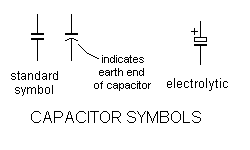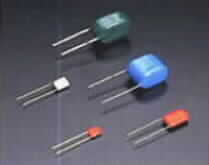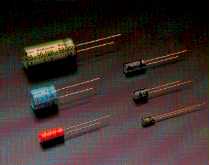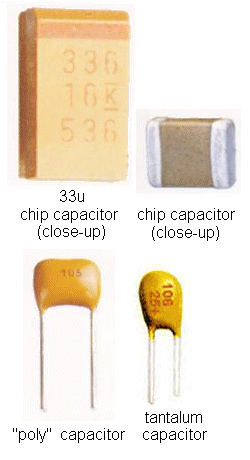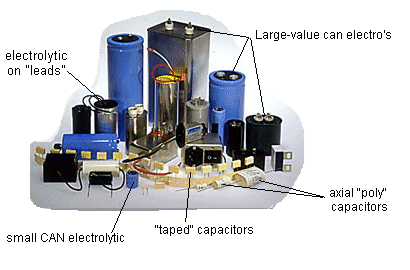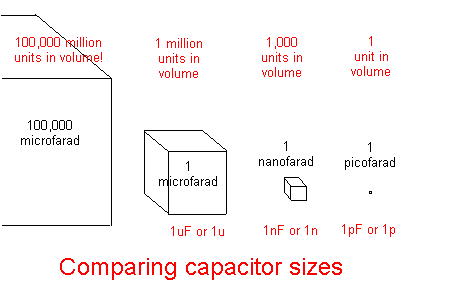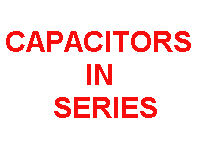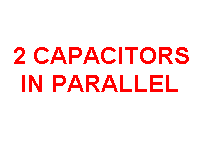|
| ||||||||||||||||||||||||
|
|
BASIC Capacitors play a very big part in electronics. They perform different functions depending on their position in a circuit and the value of the surrounding components. They come in all shapes and sizes. But this is no indication of their capacitance. You have to read the "codes" on the body to get the capacitance - that's why you need this chapter. CAPACITOR SYMBOL: The symbol for a capacitor:
To keep this course simple we will only cover three
types of capacitor:
All capacitors are basically the SAME. They consist of two plates separated by an insulating material. The material may be air, paper, plastic, ceramic, glass, mica, or a special jelly-like insulating (dielectric) chemical. The plates are made of aluminium foil or aluminium sprayed (draped) onto the plastic and to make the capacitor as small as possible, the foil and plastic is rolled up in a "sandwich." The whole package is then dipped or moulded to make it rugged and to allow the value of capacitance to be printed on the body. Some types of capacitors have colour bands on the body to indicate the capacitance.
The basic unit of capacitance is the FARAD. This is a very large value and a more-useful value is the microfarad. This is one-millionth of a farad and you can consider this is the "central" unit for electronic work as capacitance values can extend to 100,000 microfarad and less than one millionth of a microfarad. This is an enormous range and the diagram below shows the approximate size of a 100,000 microfarad capacitor, 1 microfarad, 1 nanofarad and a 1 picofarad capacitor. If we say 1pf is one unit in volume, 1nanofarad is 1,000 units in volume and 1microfarad is 1million units in volume. This gives an indication of the sizes if the capacitors were made of the same material(s). But fortunately (unfortunately) capacitors are made of many different materials, (mainly the insulating material between the layers of aluminium foil) and that's why the size of a 1n capacitor, for example, can vary in size enormously.
We will not be going into the types of insulation except to say that different materials have different voltage ratings (for a particular thickness), different stabilities over a range of temperatures, different high frequency properties, different costs and lots of other factors. These are the factors that determine the final size of the capacitor. A 1n capacitor with a 100v rating will be smaller than 1n @ 400v. The 400v capacitor will have a thicker layer of insulation. The size will change again if the capacitor is made from say, frequency-stable insulation or has a high ripple feature. Never compare sizes unless they come from the same batch. Capacitors can be placed in a circuit around either way as they are not polarised. This means they will not be damaged if connected in either direction. THE THREE TYPES OF CAPACITOR: The following three types of capacitor covers the complete range from 1p
to 100,000 microfarad: READING CAPACITOR VALUES There are two different ways to show the value of a
capacitor on the body. The value printed on a capacitor is the value in pF
(sounded "puff'). Three digits are used. The first two digits provide the
numerical value of capacitance and the third digit is the multiplier. 221 = 220p Once you know how to read the code, there is one
more step: 1,000p = 1n
n = nano The three-digit code becomes: 101 = 100p Using the decimal point In the table below, the decimal point has been replaced by the letter "p," "n," or "u." This is the best way to express a value as the decimal point can "disappear" from a circuit diagram during a printing or photocopying stage. OLDER-STYLE IDENTIFICATION: Older-style capacitors and circuit diagrams identify capacitors in microfarad. For instance: .0047 = 4n7 Other markings: .1u or 0.1mfd or 0.1 or .1 =
100n SURFACE-MOUNT CAPACITORS Capacitance values are not marked on surface-mount capacitors and size is no indication of value. The only way to find the value of a surface-mount capacitor is to measure it with a capacitance meter. ELECTROLYTICS Electrolytics are easy to read. The value is printed
on the body. The negative lead is marked with a black stripe and the positive
lead is the longer of the two. CONNECTING CAPACITORS IN SERIES
Capacitors can be connected in series for a number of reasons: 1. To obtain a "special"
value of capacitance, The formula for working out the final
capacitance of two capacitors in series is complex but a simple
"trick" is to remember: Two equal-value capacitors connected in series
will produce HALF the value (of one of them). Three caps in series will produce a
value ONE-THIRD - and so on. CONNECTING CAPACITORS IN PARALLEL
Capacitors can be connected in PARALLEL for a number of reasons: 1. To obtain a "special"
value of capacitance, The formula for working out the final
capacitance of two or more capacitors in parallel is very simple. Add the values
together.
| |||||||||||||||||||||||

